Heading out the door? Read this article on the new Outside+ app available now on iOS devices for members! Download the app.
There’s nothing like the feeling of two sets of edges connecting with fresh corduroy in arc after arc, leaving railroad tracks behind you—like an artist signing their name on a canvas. That’s the rush carving skis can offer.
With waist widths hovering in the 70- to 80-millimeter range and more dramatic sidecuts than you’ll see on all-mountain skis, these carvers are designed to help you get on edge and play with turn shape, tempo, and degree of your arcs. All models in this category are frontside-focused, built to perform at their best on groomers—hard or soft—and carve either short or long turns, or somewhere in the middle. Some have race pedigrees with constructions designed for precision and edge grip, while others have more playful and forgiving personalities.
The 15 testers who participated in our 2025 carving test at Eldora Mountain Resort in Colorado last April got a lot of satisfaction from seeing which skis leave the best trenches in the snow. By day’s end, it was clear that not all carving skis are created equal. Here are the eight unisex carving skis that rose to the top of the pack.
Whether you’re looking for a seriously directional carving ski or a more accessible option that will coax you into a beautiful carve, this year’s top performers will not disappoint.
Editor’s note: The skis on this page appear in ranked order, with the highest-scoring ski appearing at the top of the list. While we’re big fans of the Head WC Rebels e-Speed and think it sets the benchmark for what a high-performance carving ski should do, remember that testing skis is somewhat subjective. Just because our crew of nine testers deemed this ski the best of the best does not necessarily mean it’s the best ski for every type of skier. So don’t just pay attention to scores and rankings—dig into each review to learn about a ski’s strengths and weaknesses before deciding which ski might be best for you.
Check out the best women’s carving skis here
At a Glance
- Best in Test: Head Worldcup Rebels e-Speed ($949)
- Best for Firm Snow: Stöckli Laser WRT Pro ($2,079 with binding)
- Most Balanced: Völkl Peregrine 72 ($1,100 with binding)
- Most Fun: Fischer The Curv GTX ($1,300 with binding)
- Best Value: Salomon S/Max 10 XT ($800 with binding)
- Nordica Dobermann Multigara DC ($1,500 with binding)
- Blizzard Thunderbird R15 WB ($1,200 with binding)
- Rossignol Forza 70D+ Master R22 ($850)
If you buy through our links, we may earn an affiliate commission. This supports our mission to get more people active and outside. Learn more.

1. Best in Test
Head WC Rebels e-Speed
Score: 8.5/10
Dimensions: 114-68-99 mm
Lengths: 165, 170, 175, 180, 185 cm
Turn Radius: 18.2 m (180 cm)
Weight: 2,480 g (180 cm)
Pros and Cons
⊕ Very stable at speed
⊕ Superior carving chops
⊕ Dependable on firm snow
⊗ Stiff and burly
⊗ Not forgiving
It’s no secret that Head dominates at the World Cup, so it’s not a surprise that the e-Speed rose to the top of the podium in our Carving SKI Test at Colorado’s Eldora Mountain. Testers unanimously awarded these sticks high scores for carving, hard-snow integrity, and stability at speed.
“This ski is a race tool with no speed limit,” said tester Dave Wolf, a six-foot-two certified PSIA ski instructor and AMGA ski guide. “It’s a performance-oriented ski for ripping high-speed frontside arcs.”
True to form, the e-Speed employs a race-inspired layup including a World Cup Sandwich Cap construction with metal, graphene, and carbon for added responsiveness. Head also incorporates technology that helps to absorb vibration, and the wide shovel and flat tail help with turn initiation.
Tester Logan Boone, a hardgoods buyer for Boone Mountain Sports, recommends the e-Speed for advanced to expert skiers, or ex-racers looking for a step down from a race ski. “New tip and tail taper keep you from being locked in an arc, providing great turn entry and exit, which widens the demographic for this ski,” reported Boone. “It also cuts easily from short, quick turns to GS turns.”
Though perhaps more accessible than the previous model, this top-scoring ski still received lower scores for forgiveness and playfulness. Testers agreed the ski felt burly, and caution users to stay on it or the e-Speed will take them for a ride. “This ski felt as stiff as a mummy at a dance party,” quipped Sebastian Crain, a six-foot-one expert skier who weighs 180 pounds. “It’ll take an experienced skier to use it to its full potential.”
Read our full review of the WC Rebels e-Speed here.

2. Best for Firm Snow
Stöckli Laser WRT Pro
$2,079 at Utah Ski Gear $2,079 at Jans
Score: 8.41/10
Dimensions: 119-67-101 mm
Lengths: 158, 166, 172, 178 cm
Turn Radius: 14.8 m (172 cm)
Weight: 3,565 g (with ski/plate/binding)
Pros and Cons
⊕ Slays short-radius turns
⊕ Exceptionally smooth and stable
⊗ Demands attention and skill
⊗ For experts only
⊗ Expensive
The Stöckli Laser WRT Pro, our Editors’ Choice award winner last year, retains its position on the podium for another season with a silver medal and bragging rights for the highest marks in the hard-snow integrity category.
“This is a precise, specialized tool that does not suffer fools,” said Dave Wolf, a mountain guide and ski instructor. “It’s an exceptional, yet demanding ski for frontside-focused experts looking to lay tight arcs on hardpack and steep groomers.”
With its sleek aluminum top sheet and race-like geometry, testers said it looks and skis like a World Cup slalom ski. The Laser WRT Pro has a wood and metal core construction and race sidewalls—used in racing skis for power transmission and edge grip—but its wider metal edges and a more voluptuous shovel make turn initiation and grip more accessible to folks who aren’t on the national ski team.
With an included race plate and binding (which contribute to the steep price tag), testers said the 67-millimeter-waisted ski felt heavy and stiff, and gave it low marks for forgiveness. “These skis will quickly tell you where you’re going wrong in your stance and punish you for it,” cautioned Sebastian Crain, a six-foot-one expert skier. “In large radius turns, I got left behind like Kevin McCallister in Home Alone.”
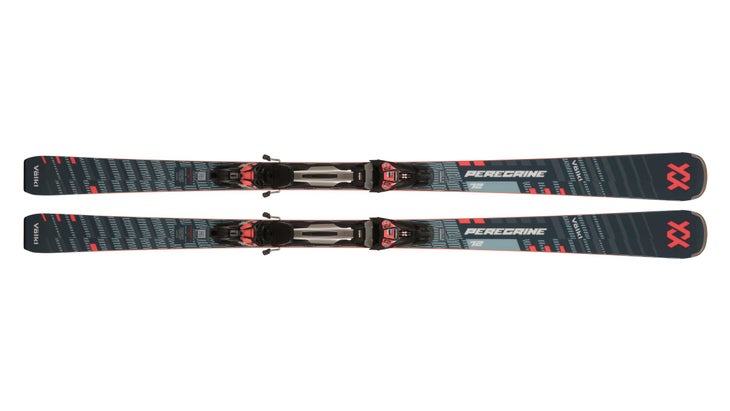
3. Most Balanced
Völkl Peregrine 72
Score: 8.05/10
Dimensions: 125-72-103 mm
Lengths: 158, 163, 168, 173, 178 cm
Turn Radius: 15.4 m (173 cm)
Weight: 3,205 g (173 cm with binding)
Pros and Cons
⊕ Agile
⊕ Easy to turn
⊕ Reliable edge grip
⊕ Large size run
⊗ Not playful
Völkl’s popular Deacon models have been swept up by the brand’s all-new Peregrine series this season. A peregrine falcon analogy is apt for the 72-millimeter-waisted model in the new line. After all, raptors are known for their agility and fast flying, and according to testers, the Peregrine 72 shares those same qualities.
“The grip on hardpack was great, and stability at speed was solid, yet you could also back the speed down to slide turns a little and the ski did not fight back,” said Josh Lynch, a Colorado-based racing coach. “East to West, this ski will work for moderate speeds to ripping, and intermediates through experts.”
The addition of lightweight and customized carbon fibers promotes agility and easy turn initiation, which supports variety in turn shapes along with speed regulation. A full layer of Titanal and a wood core mean that the Peregrine can be skied hard and aggressively, though skiers should not expect playfulness or acuity in crud.
Overall, testers characterized the Peregrine 72 as easy to energize, easy to turn on groomers and even firm bumps, and adept at all speeds.
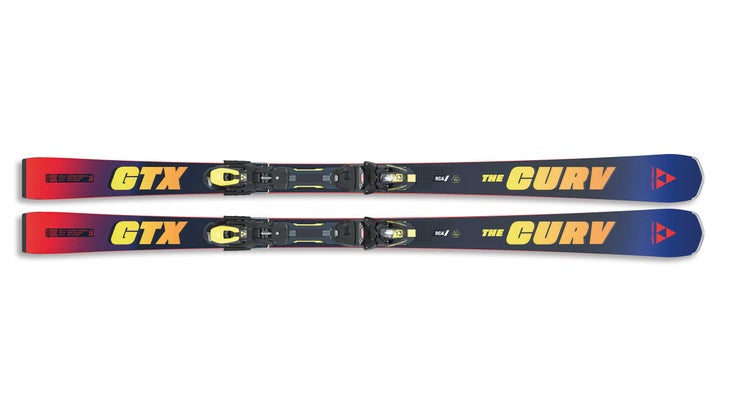
4. Most Fun
Fischer The Curv GTX
$1,300 at Utah Ski Gear $1,300 at Jans
Score: 8.01/10
Dimensions: 125-76-109 mm
Lengths: 161, 168, 175, 182 cm
Turn Radius: 16 m (175 cm)
Weight: 2,200 g (175 cm)
Pros and Cons
⊕ Nimble
⊕ Extremely responsive
⊗ Loses stability in larger turns
⊗ Can punish sloppy skiing
The same way you can be surprised on the dance floor by someone’s groovy moves, so too are ski testers sometimes surprised by a ski.
“This ski is unexpectedly nimble,” exclaimed Josh Lynch, a five-foot-nine expert skier. “It’s solid and predictable on smooth groomers and in mixed snow. While it does not have the dampness of a ski with a race plate, it makes up for it in being able to handle a variety of surfaces with confidence.”
The carving ski category is filled with single-minded groomer skis, which is why The Curv GTX’s solid all-mountain performance was a pleasant discovery. It does have a race sidewall construction—but with carbon stringers placed in a diagonal grid patterns across the ski and horizontally underfoot. Paired with a 76-millimeter waist, The Curv GTX “serves as the Swiss army knife for the frontside,” said Sebastian Crain, an instructor who has taught in both Vermont and Colorado. “Whether on bumps or on-piste, it’s just so easy to plug and play.”
Testers awarded slightly lower marks for stability at speed, agreeing that long-radius turns at high velocity were not this ski’s forté. But fleet-footedness and versatility are certainly strong suits. The result: an excellent frontside carving ski that rewards a skillful partner.

5. Best Value
Salomon S/Max 10 XT
Score: 7.61/10
Dimensions: 128-76-108 mm
Lengths: 149, 156, 163, 170, 177 cm
Turn Radius: 15 m (170 cm)
Weight: 2,130 g (170 cm)
Pros and Cons
⊕ Excels at short turns
⊕ Very forgiving
⊕ Accessible to intermediates
⊕ Great value
⊗ Falls short at high speed
⊗ Large radius turns are not its forté
In a category full of hard-charging overachievers, Salomon’s new S/Max 10 XT stands out like an avant-garde painting among the classics.
“This ski felt livelier, less damp, and less like a FIS slalom ski than other carving skis, but it could also hold an edge,” said Josh Lynch, a Colorado-based ski coach. “Intermediate level skiers will find short-to-medium radius turns accessible, and advanced skiers can enjoy how fun and playful the ski is.”
Designed for power and precision in a lightweight package, the S/Max 10 XT’s sandwich construction lowers its swing weight without sacrificing torsional rigidity. A tri-axial fiber wrap around the wood core—and carbon in the rockered tips—reduces weight and vibration.
Though nimbler and more accessible to a variety of ability levels than a race-oriented ski, testers said the 76-millimeter-waisted ski fell short at speed and in big-radius arcs. Experts may miss the stability while moving fast, but if skiers keep the S/Max 10 XT at moderate speeds and the turns shorter, even advanced skiers will appreciate how fun and playful it is.
The bottom line for Salomon’s new model, according to David Wolf, a Colorado-based tester: “It’s for frontside-oriented skiers looking for a standout, do-it-all, fun ski with an approachable and accessible construction.”

6. Nordica Dobermann Multigara DC
$1,500 at Nordica $1,500 at Ski Essentials
Score: 7.4/10
Dimensions: 121-70-101 mm
Lengths: 160, 165, 170, 175, 180 cm
Turn Radius: 16 m (175 cm)
Weight: 2,050 g (175 cm)
Pros and Cons
⊕ Extremely stable at speed
⊕ Great edge hold
⊗ Not for novices or intermediates
⊗ Too directional for bumps or variable snow
The European Dobermann is a sleek yet muscular dog breed known for its keen intelligence and agility. Nordica’s Dobermann Multigara DC embodies those canine qualities, eliciting adjectives from testers such as “dependable,” “energetic,” and “powerful.”
It’s built like a well-trained and more accessible race ski, and sold as a system with a race plate and binding. It also features Nordica’s Energy 2 Ti Double Core (the DC in the ski’s name), which includes two sheets of Titanal. An elastomer core embedded within the wood is designed to dampen vibrations.
“With its obvious race-inspired construction and confidence-inspiring burliness, this ski can take all the energy you give it and multiply it out,” said David Wolf, a six-foot-two expert skier. Testers awarded it with high marks in hard-snow integrity and stability at speed. They also praised its ability to handle a wide variety of turn shapes.
“It skis a longer radius than advertised,” said Riley Boone, a hardgoods buyer for Boone Mountain Sports in Evergreen, Colorado. “It’s fun and engaging at higher speeds, but it can shorten it up, too. I’d sell this ski to an advanced skier or an ex-racer who wants a solid performance for hardpack or boilerplate conditions.”
Don’t expect bump or loose-snow performance, though: testers gave the 70-millimeter-waisted ski lower marks for forgiveness and terrain versatility. “It’s a very specific ski strictly for frontside carving and those comfortable skiing fast,” noted Logan Riley, a five-foot-ten expert skier.

7. Blizzard Thunderbird R15 WB
$1,200 at Christy Sports $1,200 at Ski Essentials
Score: 7.12/10
Dimensions: 126-76-107 mm
Lengths: 158, 166, 174, 182 cm
Turn Radius: 15 m (174 cm)
Weight: 1, 850 g (174 cm)
Pros and Cons
⊕ Easy to carve hero turns
⊕ Dependable edge grip
⊗ Sluggish in short turns
⊗ Tips can vibrate at speed
If the Thunderbird R15 WB was in a band, it’d play bass. A skilled bassist creates an easygoing vibe and a steady pulse, but can also transform a song with a monster beat. The Thunderbird R15 WB has that versatility. Testers appreciated its accessibility to intermediates as well as its ability to excite experts with plenty of rebound energy.
“I was pleasantly surprised at how easygoing the ski was, but it can pack a punch when needed,” said Logan Boone, a professional bootfitter. “It has easy entry and easy exit and holds on hardpack, with some energy to send you into the next turn.”
With a 15-meter turn radius, the Thunderbird R15 WB prefers medium turns—testers noted that it’s not so quick edge-to-edge in short radius turns, and the tips can vibrate in a high-speed GS turn. Blizzard designed the Thunderbird R15 WB for “ease of turn engagement” on the groomers, so where the ski falls short in race-like precision, it makes up for in balanced and dependable performance.
“The ski is strong underfoot with a soft shovel and round tail,” observed Riley Boone, a hardgoods buyer. Different densities in Blizzard’s TrueBlend Piste wood core create a softer flex in the tip and tail, with a stiffer flex in the center. According to Colorado-based tester Dave Wolf, this results in “a mid-range turn radius for advanced skiers looking for consistent planks.”
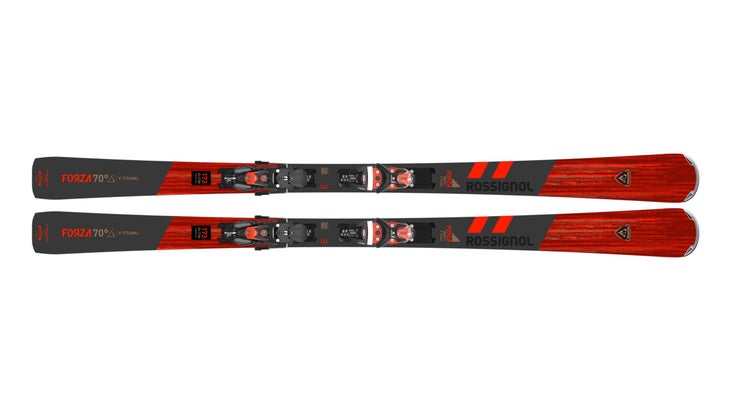
8. Rossignol Forza 70D+ Master R22
Score: 7.08/10
Dimensions: 136-78-112 mm
Lengths: 163, 173, 181 cm
Turn Radius: 14 m (173 cm)
Weight: 2,100 g (173 cm)
Pros and Cons
⊕ Stellar edge grip
⊕ Race-ski stability
⊕ Accessible for a wide range of abilities
⊗ Lacks versatility
⊗ Requires skill to reach peak performance
⊗ Limited lengths available
Forza means force or strength in Italian, an apt name for a carving ski model, but not in the way one might imagine. Testers concluded that this ski isn’t necessarily forceful—it just requires force to perform optimally. The more force you put into it, the more you’ll get out of it.
“This ski can take skill and energy, and output symmetrical arcs and trenched carves,” observed David Wolf, a six-foot-two ski instructor and AMGA guide. “Once I got used to the oversized tip and adjusted my turn initiation accordingly, I appreciated the accessibility of this precision tool.”
The R22 racing plate adds race-ski performance. Meanwhile, a metal rail placed down the middle of the wood core directs energy from tip to tail. The result? “This is a ski that really wants to carve,” said Sebastian Crain, a ski instructor and staff trainer. Because it will both coax skiers into a turn and hold firm on edge once there, we recommend the Forza for intermediates through experts.
A few caveats: Testers detected a speed limit for the Forza. It performs best at moderate speeds. Its oversized tip and penchant for carving also make it single-minded. “At the turn’s finish, it liked to hold on harder than a former college athlete clinging to the glory days, which made it hard to exit the turn,” noted Crain. “But it absolutely loves to carve.”
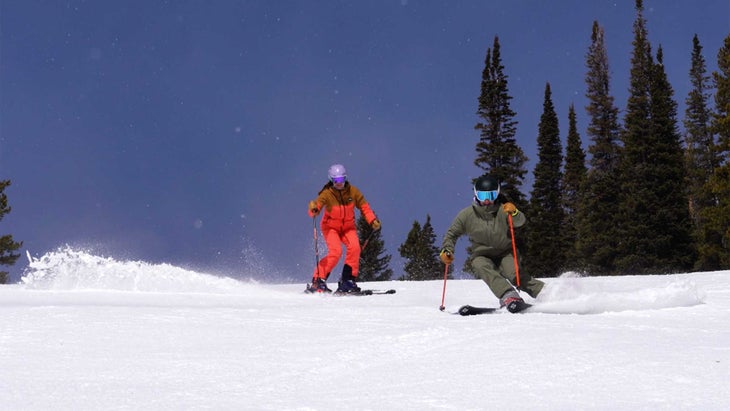
How We Test
- Number of skis tested: 15
- Number of testers: 15
- Testing location: Eldora Mountain, Colorado
- Average tester age: 40
- Average tester height: 5’8”
- Average tester weight: 148 lbs
Just west of Boulder, Colorado sits Eldora Mountain Resort—a gem of a mountain easily accessible from the Front Range. When it’s not getting hit by the Rockies’ famed upslope storms, Eldora prides itself on excellent grooming. That’s why we invited a crew of 15 expert skiers and ski industry veterans—ski shop owners and hardgoods buyers, ski instructors, ski guides, race coaches, and seasoned gear testers—to join us in slicing up Eldora’s groomers on next season’s crop of carving skis.
Every tester jumped on every ski entered into this year’s carving test and took at least one lap to determine how well the ski did what it was designed to do: get on edge and arc a beautiful carved turn. For our seasoned testers, one lap down Eldora’s groomers and into the trees and bumps is sufficient to tease out a ski’s performance characteristics.
After each run, testers fill out a digital scorecard that asked them to rate the ski across eight skill categories:
- Carving
- Hard-snow integrity
- Stability at speed
- Quickness
- Responsiveness
- Crud performance
- Forgiveness
- Versatility
Testers also provide qualitative feedback on what type of skier, terrain, and conditions the ski is best suited to. At the end of the day, we collected 15 feedback forms on each pair of skis. These notes told us how well a ski performed for our test crew, made up of all different types of skiers. We then combed through all of this data, read the feedback, and crunched the numbers to determine the best skis in the category.
Read more: Understanding SKI’s Scoring Criteria
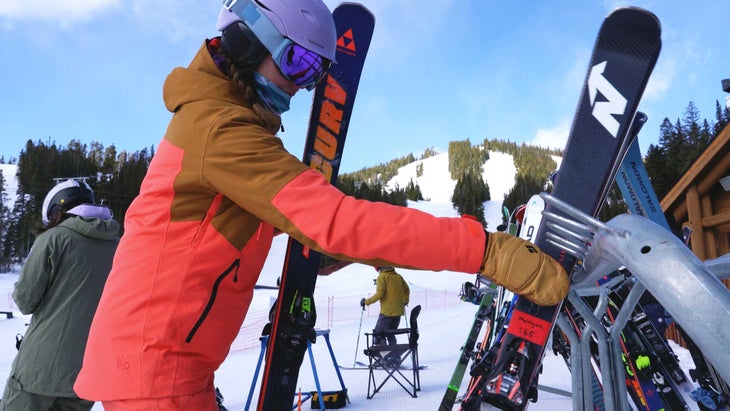
Meet the Testers
Krista Crabtree
Age: 51 | Height: 5’8″ | Weight: 130 lbs
Crabtree spent every winter weekend brown-bagging lunch and skiing bell-to-bell in New Hampshire and ski racing around New England’s storied hills. After a stint on the Bates College alpine ski team, she headed west to coach at Ski Club Vail, and then moved to the mountains above Boulder to get her master’s degree at the University of Colorado. An internship at SKI lead to eight years as an editor and director of the women’s ski test. She has been testing and writing about skis, boots, and gear since 1999.
Dave Wolf
Age: 50 | Height: 6’2″ | Weight: 183 lbs
Wolf is an AMGA ski guide and serves on the board of directors for the American Institute for Avalanche Research and Education (AIARE). He’s also a PSIA Level 2 certified ski instructor and perfects his turns in Colorado as well as Japan.
Riley Boone
Age: 31 | Height: 5’9″ | Weight: 175 lbs
Boone grew up ski racing but switched to big mountain skiing in his teenage years. In 1985, his parents opened Boone Mountain Sports in Evergreen, Colorado, which he now co-owns. He and his brother, Logan, are also hardgoods buyers for the shop. The Boone brothers and their sister have been testing, renting, and selling skis since they were kids.
Sebastian Crain
Age: 32 | Height: 6’1″ | Weight: 180 lbs
Crain began his ski career in the Breckenridge Ski and Snowboard school “just for a season,” but that season has now lasted more than a decade. After teaching at Okemo in Vermont and Aspen Ski and Snowboard School in Colorado, he moved on to Eldora Mountain Resort, where he now works as a ski instructor trainer.
Frequently Asked Questions
Who Are Carving Skis For?
Carving skis are for those who like to channel their inner ski racer or enjoy the sensation and control of arcing a ski. These narrow skis with more exaggerated side cuts are designed to chew up corduroy and hardpack snow as well as make short radius slalom turns or long arcing GS turns. In general, these skis are best suited to advanced and expert skiers who already know how to tip a ski onto its edges to carve.
However, modern constructions and profiles now make carving skis easier to turn and maneuver than ever before, meaning you don’t have to be a ski academy grad to get top turn performance from them. Savvy skiers know that the bulk of the season is made up of groomed or hardpack conditions, so why not pick a ski designed for the job? If you’re an intermediate interested in a carving ski, look for one that’s a little wider, includes tip rocker, and isn’t the heaviest ski on the rack.
What’s the Difference Between Carving Skis and All-Mountain Skis?
Carving skis are made to perform exceptionally well on groomed terrain, or “on piste.” Their construction, sidecut, and bindings are optimized for hard snow performance. All-mountain skis might be able to carve well, but their overall carving abilities might be sacrificed for better all-around performance in moguls and variable snow. Carving skis tend to have heavier wood cores and thicker sheets of metal to prioritize performance on groomers compared to ungroomed terrain.
What Length of Carving Ski Is Right for You?
Carving skis generally come in shorter lengths than all-mountain or freeride skis, but don’t be fooled: there is a lot of ski packed into all of the skis listed above. Most advanced and expert skiers opt for a carving ski that is shorter than they are tall—e.g. if you are 5’9″ (roughly 175 centimeters), you may want a carving ski that’s around 165 centimeters long.
Carving skis feature more effective edge than frontside and all-mountain skis because they have minimal (if any) rocker. So don’t be afraid to try something shorter if you’re planning to buy carving skis. Learn more about how effective edge impacts a ski’s performance here.
Why Are Carving Skis Expensive?
Most carving skis borrow from a race-inspired, top-of-the-line construction with full wood cores, vertical sidewalls, and often, a sheet or two of metal. Plus, carving skis are often system skis, meaning they were designed with a plate-and-binding combo to enhance performance and balance the flex. These high-end materials and included bindings make them expensive, but in this category, you get what you pay for. And when you’re ripping up the corduroy and leaving trenches on your first run, it’s worth every penny.
